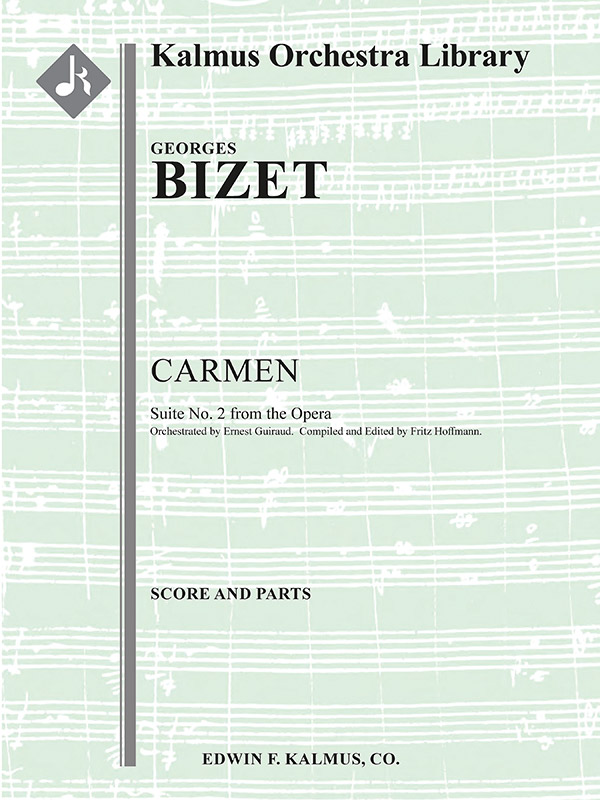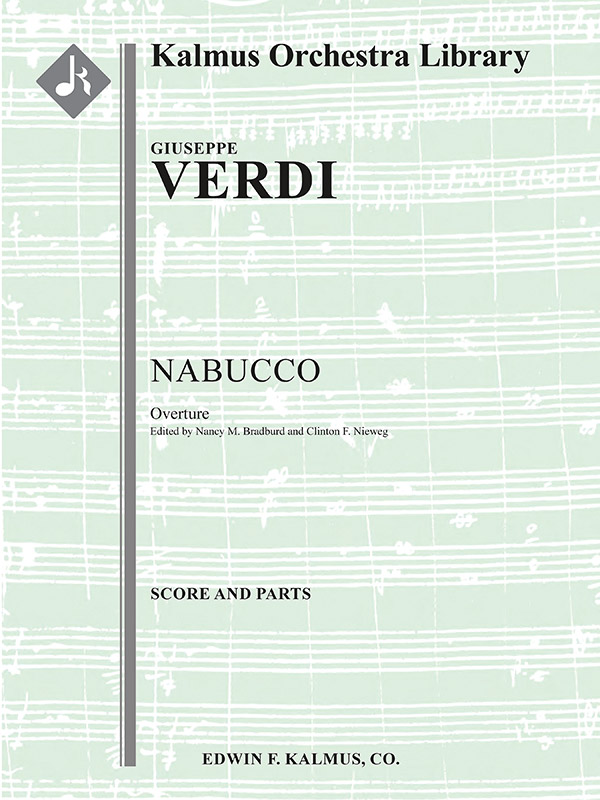-

Star Spangled Spectacular
By George M. Cohan / arr. John Cacavas
£123.0036-B399602
George M. Cohan had a deep-seated patriotism, as evidenced in such songs as Over There, Yankee Doodle Boy, and You're a Grand Old Flag. His greatest song, Over There, was written in 1917 and was the most stirring song to come out of World War I. It was immensely popular and has become a classic among popular songs. For his patriotic songs, he was awarded the Congressional Medal of Honor by President Franklin D. Roosevelt. Arranger John Cacavas (b. 1930) was chief arranger of the U.S. Army Band and twice won the Freedom Foundation's George Washington medal for his contributions to American music. He has taken a number of Cohan's greatest songs and put them into this “Spectacular” arrangement. Learn More -

Pictures at an Exhibition Finale for Band
By Modest Mussorgsky / arr. Alfred Reed, Carl Simpson
£123.0036-M910202
Mussorgky's "Pictures at an Exhibition" has long held a place of interest in the collective minds of bandsmen. This fine transcription allows today's mature concert bands to perform the Baba Yaga and The Great Gate of Kiev while staying true to the composer's original intent. At under nine minutes in length, it works well in a number of programming situations. Learn More -

Apparitions
By Anthony Iannaccone
£123.0036-10100255
The concept of APPARITIONS was inspired by Walt Whitman' brief poem of the same name. The composition deals with both appearances (or "apparitions") and true nature of an abstract idea. The three basic musical shapes which "appear" in APPARITIONS all share the pitch pattern of a falling fifth and a rising sixth. They are, in order of appearance: first, a sweeping wave of accumulating notes - a cold wind on a dark night - borrowed from the composer's first orchestra symphony; second, a musical quote from Schubert's song, THE ERLKING, in which a child pleads with his father to see an "apparition" which the father cannot see but which is terrifyingly real to the little boy; and third, a quote from a Luther/Bach chorale tune that outlines the falling fifth and rising sixth of the child's melody in Schubert's song. APPARITIONS may be performed by a symphonic band or wind ensemble. The wind ensemble will require two Bb clarinets per part and three flutes per part to comply with the divisi orchestration. Learn More -

Slavonic Dances Op. 46 Nos. 5-8, critical edition
By Antonin Dvorák / arr. Otakar Sourek
£123.0036-A696402
Two series of "Slavonic Dances," each of them consisting of eight numbers and separated by eight years, were composed by Antonín Dvorák. The idea was suggested to the composer by the publisher, N. Simrock, following the publisher's introduction to Dvorák's "Moravian Duets" by Johannes Brahms. Understanding the national characteristics and talent of the hitherto unkown Czech composer, Simrock suggested he create a series of "Slavonic Dances" in a style similar to that which had recently proved so successful in the base of Brahms' "Hungarian Dances." Using only the rhythms as the most characteristic and expressive element of Slavonic music rather than original folk dance songs, Dvorák quickly completed the first series of eight (Opus 46) for piano duet, often also orchestrating them while still composing. Considered one of the most personal, nationally most characteristic, and most famous of Dvorák's works, this critical edition of Op. 46, Nos. 5-8 by Otakar Šourek was based on original sources. Instrumentation: 2+Picc.2.2.2: 4.2.3.0: Timp.Perc(3-4): Str(9.8.7.6.5 in set). Learn More -

Carmen Suite No. 2
By Georges Bizet / arr. Ernest Guiraud, Fritz Hoffmann
£119.0036-A118802
Ernest Guiraud (1837-1892) was a colleague and good friend of Bizet's. After Bizet's death, he composed the recitatives still commonly used in Carmen. Between 1880 and 1882, he compiled two orchestral suites from this opera, each in five movements, for Choudens, Bizet's publisher. The second of these two suites included the "Marche des Contrebandiers," "Habanera," "Nocturne," "La Garde Montante," and "Danse Bohème." In this second suite, Guiraud stayed fairly close to Bizet's original orchestration. Around 1906, the German composer-conductor Fritz Hoffmann (1873-19xx) orchestrated "Chanson du Toréador," from bars 1-58 and 117-27 of the aria from Act II, for inclusion in a publication of the Suite by a German publisher. Instrumentation: 2dPicc.2(2dEH).2.2: 4.2.3.1: Timp.Perc(3): Hp: Str(9-8-7-6-5). Hoffmann's edition also includes the option to perform, through doubling and cues, with a reduced orchestration of as little as 2.1.2.0: 2.2.1(BTbn).0: Timp. Str. Learn More -

Concerto for Violin No. 4 in D minor, Op. 31
By Henri Vieuxtemps
£119.0036-A222402
Compared to Niccolò Paganini by friend Robert Schumann, Henri Vieuxtemps (1820-1881) was a well-known virtuoso violinist of the Franco-Belgian violin school in the mid-19th century. Aspiring towards becoming a composer also, most of his output was for the violin, and his seven violin concerti remain the reason he is generally known to audiences and musicians around the world still today. Though a virtuoso himself, his violin writing never indulged in sheer virtuosity for its own sake, and he quoted as having said, “Not runs for the sake of runs - sing, sing!” His Concerto No. 4 in D minor, written around 1850 while serving in St. Petersburg for a period of five years as Czar Nicholas I's solo violinist, was Vieutemps favorite of the seven concerti. A grandly imposing work in four movements, it shows the composer's ability to not only write exciting string music but also to invent melodies of sensuous warmth. Learn More -

Three Revelations from Lotus Sutra: Movement I - Awakening
By Alfred Reed
£119.0036-B394302
Three Revelations from the Lotus Sutra is an attempt to realize in music three different states of man's soul in his quest for ultimate perfection. The Lotus Sutra is the teaching of human respect, self-perfection and world peace – in a word, humanism, leading mankind from division to unity, from discord to harmony, from conflict to peace. I. The first movement, Awakening, (To Awaken to the Light of the Universe) portrays the vastness and richness of the experience of the human mind on expanding its field of view from the narrow confines of daily life to the contemplation of, and merging with, the entire universe. II. Contemplation (To Contemplate the Depths of the Soul) represents a turning-away of the mind from the “outer” to the “inner” universe -- the attempt to fathom the limitless possibilities of the human consciousness in its quest for identity, to answer the eternal questions beginning with the word “Why?” III. Rejoicing (To Rejoice in the Beauty of Peace) depicts the realization that, while on earth, peace is not merely the absence of war, destruction, pain and suffering, but a thing of beauty in and of itself, and an occasion for heartfelt rejoicing on the part of all men everywhere, who share the same eternal quest as true brothers. This suite was commissioned by, and is reverently dedicated to, Rissho Kosei-kai, on the occasion of the 77th birthday of its founder and president, the Reverent Nikkyo Niwano. Program notes extracted from the Wind Repertory Project. Learn More -

Nabucco: Overture
By Giuseppe Verdi / arr. Clinton Nieweg, Nancy Bradburd
£119.0036-A220602
Nabucco, a retelling of the biblical story of Jewish exile under the Babylonian King Nebuchadnezzar, was Giuseppe Verdi's first major operatic success, and was written reluctantly, following a difficult period in the composer's life. Having lost his young wife, Margherita, in the summer of 1840, and seeing his second opera, Un giorno di regno, fail disastrously, closing after only a single performance in September 1840, Verdi was left understandably depressed and prepared to give up on music altogether. However, Bartolomeo Merelli, who ran the famed Milan opera house, La Scala, urged Verdi to write another opera. Verdi wrote Nabucco in 1841, and it was an instant commercial and critical success upon its premiere in 1842. Learn More -

Nutcracker Ballet (complete reduced orchestration)
By Peter Ilyitch Tchaikovsky / arr. R. Mark Rogers
£119.0036-A927501
The Nutcracker has achieved the status of being the world’s most popular and most often performed ballet. This is the first edition with a complete full score to accompany William McDermott's 1969 reduced orchestration of the ballet with all newly engraved parts, edited and revised by Mark Rogers. With this publication, smaller ballet companies and touring groups finally have access to an affordable, quality edition of this celebrated masterpiece. Learn More -

Peer Gynt: Suite No. 1, Op. 46
By Edvard Grieg
£119.0036-A152202
The great Norwegian playwright Henrik Ibsen's poem "Peer Gynt," one of his greatest works, tells the tale of a young man so full of bravado, exuberance of spirit, wanderlust, and wantonness, that his road will inevitably lead to perdition unless saved by a woman, much as in Goethe's "Faust." The likewise great Norwegian composer, Edvard Grieg, was asked by Ibsen in 1874 to write incidental music to accompany the play, to which Grieg reluctantly agreed. Over a decade after composing the full incidental music, Grieg extracted eight movements and divided them into two four-movement suites, both of which were highly successful and the only way one could hear the music Grieg wrote for the play for many years as the original score was not published until 1908, one year after the composer's death. "Suite No. 1" includes: I. "Morning," II."The Death of Åse," III. "Anitra's Dance," and IV. "In the Hall of the Mountain-king." To make this edition as accessible as possible, clarinet, trumpet, and horn include both the original instrument key and a transposition part to those instrument keys in common use today. The tenor trombone parts, originally written in tenor clef, also include a bass clef part for ease of use. Instrumentation: 2+Picc.2.2.2: 4.2.3.1: Timp.Perc(2): Str(9.8.7.6.5). Learn More





